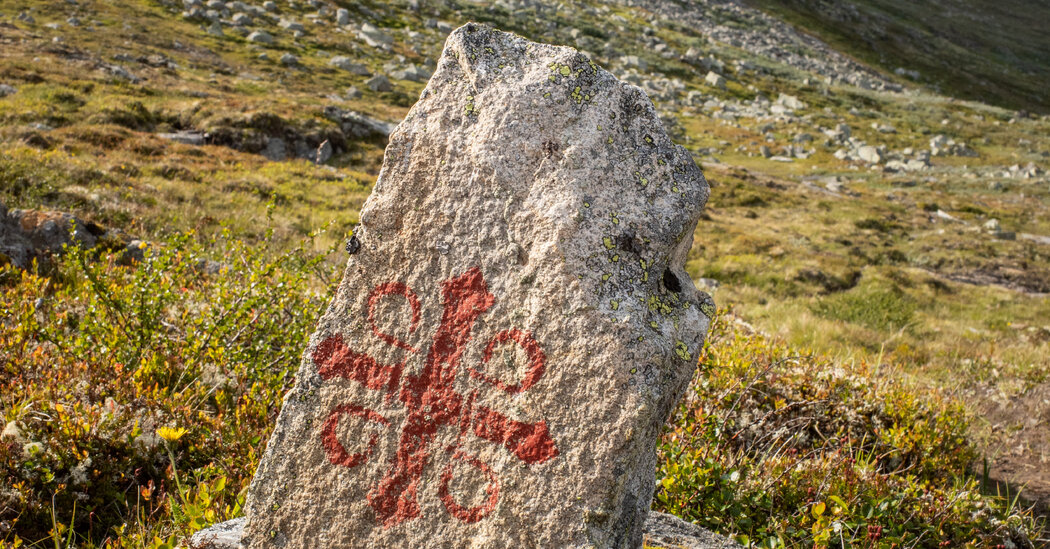Our hike began with a jolt of adrenaline: Within the very first hour, as we headily sampled wild blueberries and raspberries, a pair of fit Norwegians zoomed past us downhill on their bicycles, narrowly avoiding us on the thin forest path. We hadn’t heard them coming; the woods had absorbed the sound of their approach.
Though we didn’t know it at the time, the two cyclists would be some of the only people we’d encounter in the next nine days.
My partner and I were just outside Tynset, a small town some 160 miles due north of Oslo — just south of where Norway thins and extends all the way to the Arctic Circle and, then, further east, touches Russia. Earlier in the day we’d begun our125-mile hike along part of the Osterdalsleden, or Eastern Valley Trail, a pilgrimage route that leads north to the city of Trondheim.
The Osterdalsleden is one of nine paths known collectively as the St. Olav Ways, a network of pilgrimage routes that converges on Trondheim’s Nidaros Cathedral — the burial site of Olav Haraldsson, the canonized Viking king who helped Christianize Norway.
In time, these historical pilgrim paths to Nidaros became the main transportation routes between Oslo and Trondheim. But the commercial traffic now makes use of highways and railroads, allowing pilgrims and hikers to walk the trails in peace, an example of genuinely sustainable slow tourism.
With an average rate of around 14 miles a day, we didn’t have to walk overly quickly — though the altitude gain of around 13,000 feet overall worked to slow us down.
The trail wove up and down through lush forests, flat and hilly wetlands and bogs, around mountains and lakes, inside a national park, within muddy cattle areas, across rivers — some of which had to be crossed by foot, leading to properly soaked feet — and along a few paved roads.
The highest point of the trail fell within Forollhogna National Park, a protected area known for its “gentle” mountains. Having ascended to over 4,000 feet above sea level, bathed in a silence only periodically interrupted by birds and sheep bells, I found myself returning to the word “wasteland.” The landscape was simply so barren, so vast. I later discovered that the area was classified as a “fjell,” or fell, a high plateau or mountain tundra above the tree line, that’s common to northern Europe. Indeed, only once I returned to the valley below and saw the trees did I realize I had failed to notice their absence during the previous days.
To say that this hike was different from the pilgrimage I completed in Shikoku, Japan, two springs ago would be an understatement. The trek on Shikoku was comfortable; I often slept at temples, and I came across a konbini, or convenience store, every few hours. Moreover, in Japan, I constantly met strangers who offered help: a car ride, a meal, a place to stay.
On the Osterdalsleden, we had to carry all of our meals with us as freeze-dried food packs. Rivers supplied our water. We had to carry all the usual essential camping gear, including a stove, eating utensils and an ax for extra safety.
We were also constantly battling soggy feet, despite our waterproof boots. We were lucky if we managed to keep our feet dry for more than 30 minutes at a time.
But perhaps the biggest difference was the lack of people. In Norway, there was hardly anyone around.
Shortly before reaching the village of Singsas, while walking through a lush forest about halfway through our hike, we came across three biologists from Trondheim who were searching for a plant called the great yellow gentian (Gentiana lutea). They invited me to sample it; it was extremely bitter.
The next night, under a light rain near the Gaula River, we were overtaken on the trail by a couple of young pilgrims from the Czech Republic. They had very small backpacks, no walking sticks, no water filter and no boots (they were wearing light trail running shoes). They said that they were planning to walk as quickly as they could and were hoping to finish one day earlier than us. They ran ahead, and we never saw them again.
The berries, however, were ubiquitous. In addition to blueberries and raspberries, we found fistfuls of white currants, rowan berries, lingonberries, crowberries, wild strawberries and cloudberries, the last of which I’d never tried before.
Cloudberries are interesting little fruits. They grow in wetlands like tundras, bogs and marshes, requiring acidic ground with a pH level between 3.5 and 5 — a very narrow range. A curious Norwegian law dating back to 1970 forbade the picking of unripe cloudberries based on the belief that the plant would be harmed if its fruit were snatched early, leaving it unable to produce berries the following year. Since the law was nearly impossible to implement, it was removed in 2004.
Early on, I suffered one notable setback: My inflatable mattress sprung a leak, so I spent the first two nights sleeping — or rather, not sleeping — on the hard ground. But soon I passed a little supermarket that sold thin foam mattresses, and afterward I was happy to camp again.
I knew there were a few cabins and farms scattered along the route, but we wanted to be flexible with our schedule and couldn’t figure out a sensible way to book them ahead of time. On day three, as we entered the national park, walking along the towering Mount Forollhogna to the left and the placid Lake Forollsjoen to the right, we found a small wooden hut unattended on a hill. It was earlier than we would have preferred to stop, but heavy rain seemed to be on the horizon, so we settled in for the night.
In the end, we ended up camping five nights out of nine. For the remaining nights, we tried calling the farm hosts just a few minutes before our arrival, and it all worked out in our favor: We were luckily the only pilgrims on the road those days. The accommodations were basic; some lacked a shower. But fancier — and consequently more expensive — options were available.
My backpack often felt too big and heavy for me. But during our longest days, much to my surprise, I seemed to discover newfound stamina.
The penultimate day was an exception. I felt particularly weak and tired. That morning, we passed through a short stretch marked deep burgundy in the GPS app I used to track our route — which meant that the incline was quite steep (about 26 degrees). After struggling, panting and taking way too long to reach our destination for the day, I realized I was sick, likely from drinking water that wasn’t entirely cleaned by my filter.
As luck would have it, we stayed at a beautiful farm with wooden huts for pilgrims that night, and I sweated out the sickness. Come morning, the rain had stopped and I was on the mend — and we were ready to hit the road for our last day of walking: 14 miles following the Nidelva river into Trondheim, toward its spiky cathedral and St. Olav’s shrine.
Follow New York Times Travel on Instagram and sign up for our Travel Dispatch newsletter to get expert tips on traveling smarter and inspiration for your next vacation. Dreaming up a future getaway or just armchair traveling? Check out our 52 Places to Go in 2025.
Marta Giaccone is a photographer based in Rome and Tallinn, Estonia. You can follow her work on Instagram.
The post A Pilgrim Route in Norway: Berries, Bogs and a Viking King appeared first on New York Times.




